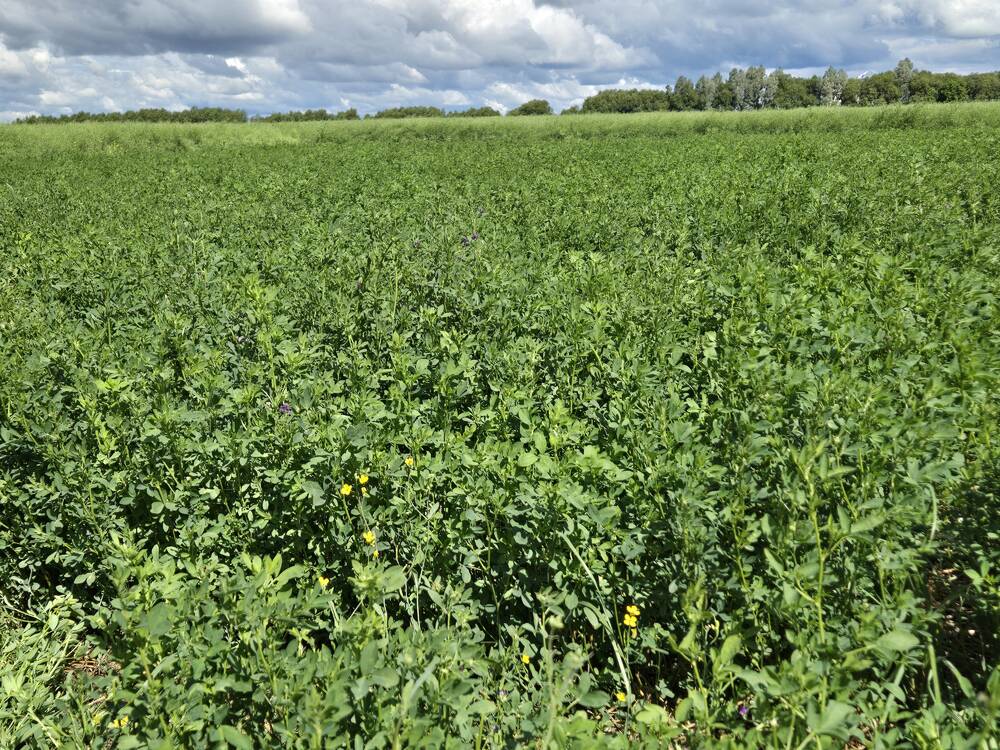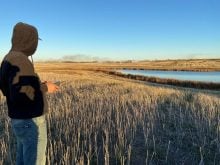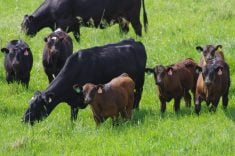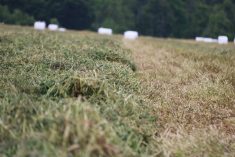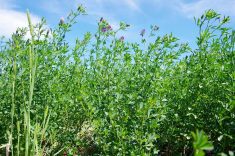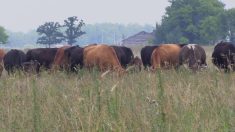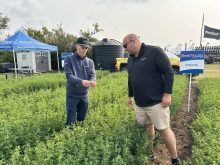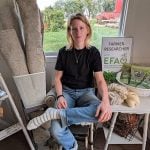A project at the Parkland Crop Diversification Foundation in Roblin is studying the impact of different phosphorus rates and use of an oat nurse crop in establishing hay crops.
The foundation and Ducks Unlimited Canada launched the study in June last year, aiming to identify best management practices for maximizing forage yields in perennial crops. The study will wrap up this fall.
At an Aug. 8 field day hosted by the foundation, DUC winter wheat specialist Alex Griffiths took participants to the field to share more about the study. The hay was cut in the middle of July, so attendees saw several weeks of regrowth.
Read Also
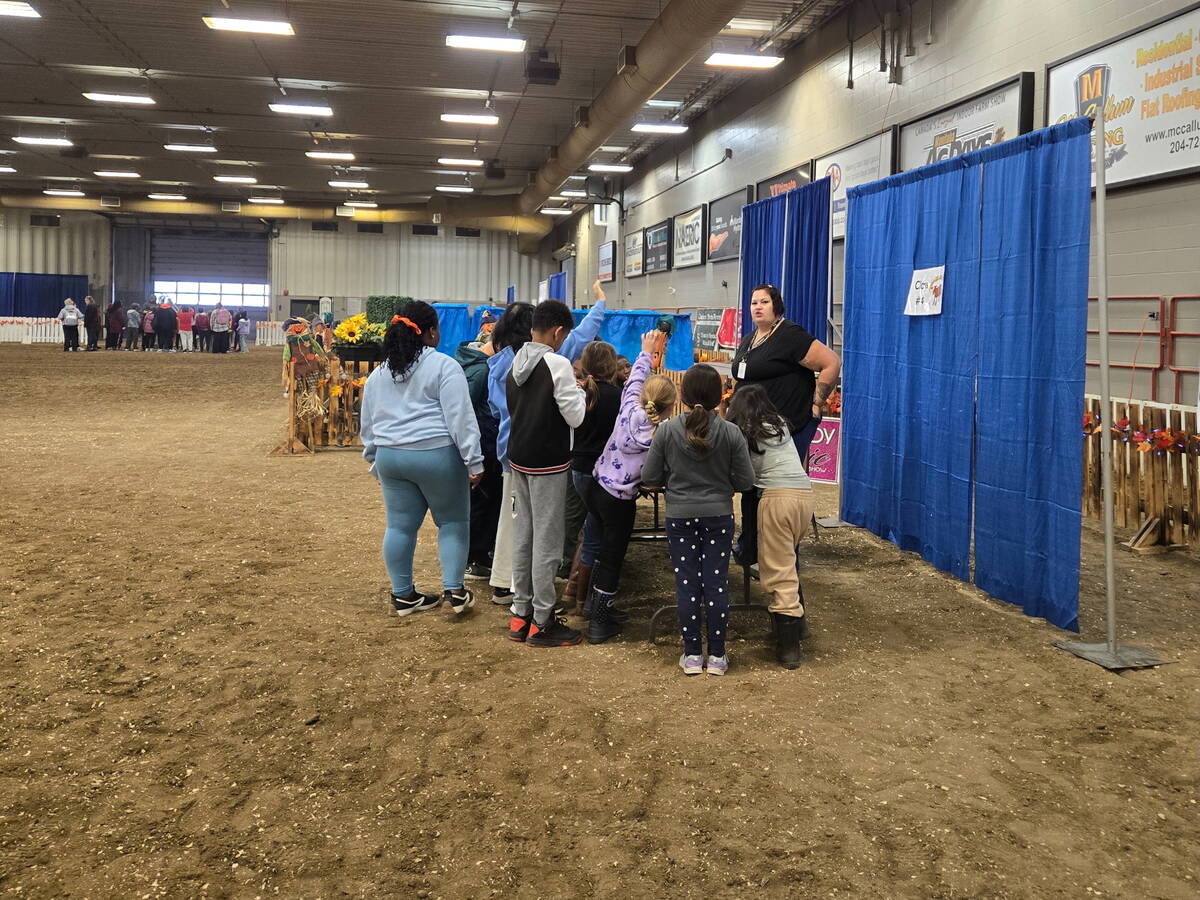
Hands-on with agriculture draws students to AG EX
Urban students flock to MooMania and EweMania at Manitoba AG EX 2025 to get a taste of cattle and sheep production and where their food comes from
A common method for establishing perennial forage involves planting with a cereal nurse crop such as oats or barley. Typically, the nurse crop is cut for greenfeed by mid-summer, allowing the forage to grow with unrestricted access to sunlight, water and nutrients.
In some cases, the nurse crop is harvested for grain, often for livestock feed. This approach offers producers a harvestable crop during the establishment year, even when the nurse crop is sown at a reduced rate.
“That’s pretty well the standard way [for] 80 per cent of producers I work with,” Griffiths said.
However, observations suggest that nurse crops may negatively affect growth of perennial forage, leading to lower hay yields in the second year. While oats seem less competitive than barley, evidence shows that establishing a forage crop without a nurse crop could result in stronger growth and higher yields in subsequent years.
“What I would say is probably your best bet is a reduced rate. If you can just go at a lighter rate, or even cutting sooner, too, that seems to help with your regrowth establishment,” Griffiths said.
Proper planning for carry-over feed can also help producers transition to this method, he added.
Why it matters: By identifying optimal seeding practices and nutrient management, the research aims to help producers achieve better long-term growth and higher yields.
The study focuses on the effects of both a nurse crop and application of starter phosphorus. Where an oat nurse crop was used, the oats were harvested for grain in mid-October. Performance data, particularly on forage yield, is now being collected.
DUC provided the hay seed, which is a mix of alfalfa, brome and timothy. The oat variety, Haymaker, is known for its height, broad leaves and large seed size. The initial plan was to cut the oats for greenfeed, but it was later harvested for grain.
The study followed a randomized complete block design with 18 entries, each replicated four times. Each harvest plot was 19.2 square metres. Nitrogen was not added since the soil already contained 57 lb./acre. Phosphorus levels and seeding rates varied.
Seeding on June 15 placed seeds at half an inch depth to reach adequate moisture. The field was prepared with a glyphosate application on May 26, followed by tillage on June 7 and June 15. The grain was harvested Oct. 19.
For the nurse crop, three different rates were used: two bu./ac. (full rate), 0.5 bu./ac. (quarter rate), and no nurse crop. The hay mix, which included alfalfa, brome and timothy, was tested at three seeding rates: eight lb./ac., 12 lb./ac., and 15 lb./ac.
Phosphate was either not added or applied at a rate of 25 lb./ac. In the second year, the hay was either cut once or twice, depending on the treatment.
Late June rain last year provided favourable conditions for all treatments, leading to good growth. Plots with only the hay mix were well established and effectively managed weed competition. The oat treatments showed strong oat growth but the hay crops varied. The combination of a full rate of oats and eight lb./ac. of hay mix resulted in the poorest hay growth.
James Frey, an applied research specialist with Manitoba Agriculture, noted significant differences in hay growth, particularly given extremely dry conditions of the previous year.
“We also saw very, very striking differences in the amount of hay in year one. And bearing in mind that last year was an extremely dry year, we had alfalfa and less of the brome … but most of the alfalfa [was] mid-thigh, while in the quarter rate oats it was very negligible, probably about half that height.
“So, there’s … probably a good chance that … at least some better feed would come even in year one, if we were cutting it quite late in the season.”
Initial observations from 2023 suggest that plots without an oat nurse crop had better growth. Yield data collected in 2024 will be needed to create best management practices to be shared with producers.
Griffiths emphasized the importance of optimizing seeding practices for successful perennial crops.
“There’s a thousand different ways that you can get successful season perennials,” he said.
Better results were seen when seeding a heavier rate of perennials or using Premium Hay Max from Northstar DSV, which consists of 65 per cent alfalfa, 30 per cent meadow brome and five per cent timothy.
Pamela Iwanchysko, a livestock specialist with Manitoba Agriculture, highlighted the benefits of avoiding cover crops.
“My general recommendation to producers is … if you don’t have to use that cover crop over the long term, you definitely get more yield. You get better quality … it’s just a win-win. In the planning perspective, if you don’t have any alfalfa in the stand, it’s time to rejuvenate that stand.”


